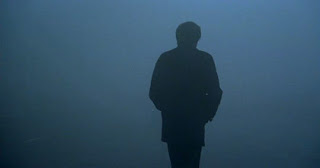Screen shot courtesy of If Charlie Parker Was a Gunslinger, Tom Sutpen's great blog.
Women in photos.
Women in windows. Women all
around Niccolò in Michelangelo Antonioni’s Identification
of a Woman. A filmmaker and a
divorcee, Niccolò falls in and out of relationships on his quest to discover the woman – his ideal conception of the opposite
sex. He’s searching for a woman who’ll
play the lead role in his next film as well as satisfy his sexual desires. Niccolò meets not one, but two women: the brusque,
upper class Mavi and the salt-of-the-earth actress, Ida. With both, however, Niccolò’s projections do
not correspond with the actual relationships.
Antonioni handles the great divide
between man and woman with a more subdued, streamlined technique than his
previous works, yet he still retains a narrative opacity (women are never “identified,”
per se, and relations dissolve without finite reasoning). Heavy on interior shots of apartments,
mansions, summer houses, Antonioni films his characters in a constrained,
(over-)developed Italy (Gone are the partially constructed skyscrapers seen in L’Eclisse.), cut off from nature. This is a sheltered, banal, and paranoid
Italy, where the elite -- Mavi’s crowd -- gather in the cavernous rooms of a
mansion, eye-balling Niccolò, the stranger intruding on the party.
Niccolò’s detachment carries over
into his love life. A professional side
effect, he remains a few steps removed from intimacy, moving towards glacial
observation, which ultimately dissolves his relationships. It happens with Mavi. It happens with Adi. And one could imagine that it happened with
his ex-wife.
This meet-connect-break-up schema
plays out in Identification like twin
narratives laid back-to-back.
Relationships start serendipitously: Niccolò encounters Mavi over the
phone while visiting his sister – a gynecologist. The glimpse of Ida at a theatre performance
ignites his interest in her. Niccolò and
the women mine their connection, going over to each other’s homes, going on
trips. But then, an inevitable decline
and dissolution occurs between Niccolò and the women. In the film then it’s meet, retreat, repeat.
What triggers the break-ups? It’s hard to say – Mavi’s abandonment and
Ida’s pregnancy? Maybe. The beginning of
the end perhaps occurs when Identification
breaks out of the closed quarters of the civilized world and into the natural
one.
Divisive at the time it screened
at festivals, both UK and US critics attacked the film, firing that old qualm at Identification – a film with style
but no substance. Writing for The Spectator, Peter Ackroyd, for instance,
called Identification “…a picture
that offers an extraordinary visual surface, but one in which is troubled by a
certain irresolution or inconsequence.” Besides
being chided for its lack of significance, some blasted the film for its hit-you-over-the-head
obviousness. “Predictably, Antonioni
positions his actors in a thick fog at least once – catch the metaphor?” Edward Guthmann wrote during Identification’s US theatrical premiere.
Yet look at this set piece, of Niccolò and Mavi driving through a dense
wall of grey: the caution light that blinks a dot of yellow amid the monochrome
color; the panel truck that emerges like a phantom; and the orange glow that
surrounds Mavi’s head as she lights up a cigarette to calm her nerves.
The scene plays out again with a
different landscape later on. In a small boat,
Niccolò and Ida drift beyond Venice, into a lagoon. Cut from civilization, it’s in these big scenes
where nature turns supernatural, a public yet private space, which these
relationships upend. It’s only man,
woman, and their environment – alone.
The elementary situation causes a rift, a perspective to shift, leading
to downfall. The melancholy seeps into
them, priming them for separation.
Addendum:
In the US, Identification was an unfortunate casualty of criticism. Antonioni’s film played at the 1982 New York
Film Festival. Vincent Canby’s review
eviscerated it, squelching Identification’s
chance for distribution. From what I
gather from my research, the film never had a proper theatrical release until 1996.

No comments:
Post a Comment